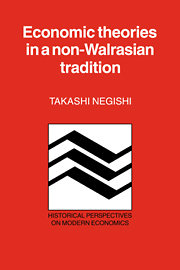Book contents
- Frontmatter
- Contents
- Preface
- 1 Anti-neoclassical or non-Walrasian economic theories
- Part I Increasing returns and diminishing cost
- Part II Wages and profit
- Part III International trade and investment
- Part IV Markets and money
- 12 Jevons, Edgeworth, and the competitive equilibrium of exchange
- 13 Menger's Absatzfähigkeit, a non-Walrasian theory of markets and money
- 14 The Marshallian foundation of macroeconomic theories
- Notes
- References
- Author index
- Subject index
13 - Menger's Absatzfähigkeit, a non-Walrasian theory of markets and money
from Part IV - Markets and money
Published online by Cambridge University Press: 21 September 2009
- Frontmatter
- Contents
- Preface
- 1 Anti-neoclassical or non-Walrasian economic theories
- Part I Increasing returns and diminishing cost
- Part II Wages and profit
- Part III International trade and investment
- Part IV Markets and money
- 12 Jevons, Edgeworth, and the competitive equilibrium of exchange
- 13 Menger's Absatzfähigkeit, a non-Walrasian theory of markets and money
- 14 The Marshallian foundation of macroeconomic theories
- Notes
- References
- Author index
- Subject index
Summary
In the history of economic science, Menger is usually recognized, with Jevons and Walras, in connection with the marginal revolution, the nearly simultaneous but completely independent discovery in the early 1870s of the principle of diminishing marginal utility as the fundamental building block of static microeconomics. There are, however, more dissimilarities than similarities between, say, Walras and Menger. What Menger was aiming at was rather what may be called disequilibrium process analysis than a theory of static equilibrium, which Walras gave us beautifully (Blaug 1978, pp. 309–24, and Hayek 1973). Indeed, it is Menger who is the first and the greatest non-Walrasian economist (Negishi 1985).
The role of Unsicherheit (uncertainty) has been emphasized sufficiently in the modern exposition of Menger's theory of money. For example, Streissler (1973a) pointed out that prices for the same physical commodities are not numbers but stochastic variables in Menger's vision. He argued that Menger suggested a liquidity theory of money, more general than the Keynesian one, on the basis of this stochastic price variation, a variation that is of little economic significance for commodities of everyday regular demand and supply but becomes important only in decisions with regard to the accumulation of wealth.
- Type
- Chapter
- Information
- Economic Theories in a Non-Walrasian Tradition , pp. 158 - 168Publisher: Cambridge University PressPrint publication year: 1985

